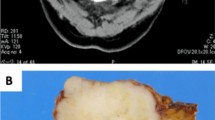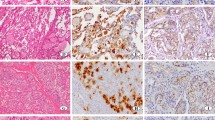Abstract.
The purpose of the present study is to determine the presence and distribution of epithelial and myoepithelial cells in mucoepidermoid carcinoma (MEC) of salivary glands and to compare them with normal salivary gland tissue and other primary carcinomas. This is in order to establish novel diagnostic criteria and to better understand MEC histogenesis. Formalin-fixed paraffin-embedded tissues from ten well-differentiated MECs, three adenoid cystic carcinomas (ACC), four acinic cell carcinomas (AC), and three epithelial-myoepithelial carcinomas (EMCC) of salivary glands were studied with immunohistochemistry using antibodies that recognise antigens indicative of epithelial and myoepithelial cell differentiation. An anti-mitochondrial antibody was also employed. Normal salivary tissue was present for comparative study in non-tumorous areas of the same section from 12 cases. MEC contained numerous keratin-positive cells. Anti mitochondrial antibody was diffusely positive in all ten of these tumours. Smooth muscle actin, h-caldesmon, and smooth muscle heavy chain myosin, which are indicative of myoepithelial cell differentiation, were negative. Rare cells in only one case were stained by calponin. Cytokeratin 14 (CK14) and anti mitochondrial antibody stained cells located mainly at the periphery of neoplastic nests and cystic spaces, while CK7 was mainly present in cells bordering gland lumina (zoning pattern). The immunohistochemical cell profile was similar to that seen in striated normal ducts. All others tumours studied showed a different immunohistochemical pattern, mostly consisting of a lack of mitochondrion-rich cells and the presence of myoepithelial cells in ACC and EMCC. Immunoreactivity in MEC for CK7, CK14 and mitochondrial antibodies appears as a peculiar pattern of staining, different from that of other salivary gland tumors; this seems helpful for diagnostic purposes. In addition, a differentiation of the "striated duct phenotype" is suggested.
Similar content being viewed by others
Author information
Authors and Affiliations
Additional information
Electronic Publication
Rights and permissions
About this article
Cite this article
Foschini, M.P., Marucci, G. & Eusebi, V. Low-grade mucoepidermoid carcinoma of salivary glands: characteristic immunohistochemical profile and evidence of striated duct differentiation. Virchows Arch 440, 536–542 (2002). https://doi.org/10.1007/s00428-001-0585-6
Received:
Accepted:
Published:
Issue Date:
DOI: https://doi.org/10.1007/s00428-001-0585-6




